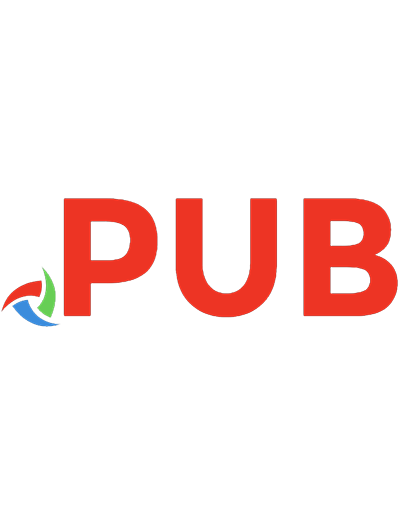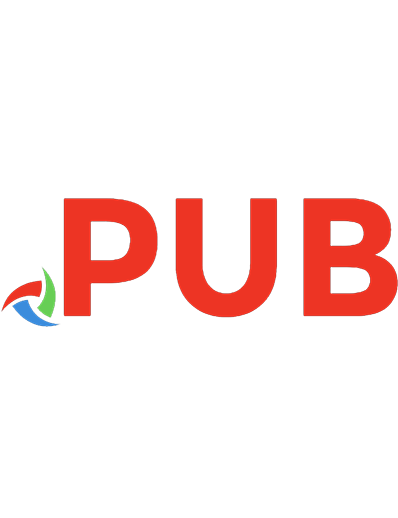R Markdown Cookbook (Chapman & Hall/CRC The R Series) [1 ed.] 0367563835, 9780367563837
This new book written by the developers of R Markdown is an essential reference that will help users learn and make full
640 129 10MB
English Pages 359 [331] Year 2020
Table of contents :
Cover
Half Title
Title Page
Copyright Page
Dedication
Table of Contents
List of Tables
List of Figures
Preface
About the Authors
1 Installation
1.1 Use a Pandoc version not bundled with the RStudio IDE
1.2 Install LaTeX (TinyTeX) for PDF reports
1.3 Install missing LaTeX packages
2 Conceptual Overview
2.1 What happens when we render?
2.2 R Markdown anatomy
2.2.1 YAML metadata
2.2.2 Narrative
2.2.3 Code chunks
2.2.4 Document body
2.3 What can we change to change the results?
3 Basics
3.1 Code chunks and inline R code
3.2 Write Markdown in the RStudio visual editor
3.3 Render an R script to a report
3.4 Convert R Markdown to R script
3.5 R Markdown Notebooks
4 Document Elements
4.1 Insert page breaks
4.2 Set the document title dynamically
4.3 Access the document metadata in R code
4.4 Unnumbered sections
4.5 Bibliographies and citations
4.5.1 Changing citation style
4.5.2 Add an item to a bibliography without using it
4.5.3 Add all items to the bibliography
4.5.4 Include appendix after bibliography (*)
4.6 Generate R package citations
4.7 Cross-referencing within documents
4.8 Update the date automatically
4.9 Multiple authors in a document
4.10 Numbered figure captions
4.11 Combine words into a comma-separated phrase
4.12 Preserve a large number of line breaks
4.13 Convert models to equations
4.14 Create an animation from multiple R plots
4.15 Create diagrams
4.15.1 Basic diagrams
4.15.2 Adding parameters to plots
4.15.3 Other packages for making diagrams
4.16 Escape special characters
4.17 Comment out text
4.18 Omit a heading in the table of contents
4.19 Put together all code in the appendix (*)
4.20 Manipulate Markdown via Pandoc Lua filters (*)
5 Formatting
5.1 Fontcolor
5.1.1 Using an R function to write raw HTML or LaTeX code
5.1.2 Using a Pandoc Lua filter (*)
5.2 Indent text
5.3 Control the width of text output
5.4 Control the size of plots/images
5.5 Figure alignment
5.6 Verbatim code chunks
5.6.1 Show a verbatim inline expression
5.7 Line numbers for code blocks (*)
5.8 Multi-column layout (*)
6 LaTeX Output
6.1 Add LaTeX code to the preamble
6.2 Pandoc options for LaTeX output
6.3 Add logo to title page
6.4 Include additional LaTeX packages
6.4.1 Loading LaTeX packages
6.4.2 Example packages
6.5 Control the placement of figures
6.5.1 Floating environments
6.5.2 Prevent figures from floating
6.5.3 Force floats forward
6.5.4 Adjust LaTeX placement rules (*)
6.6 LaTeX sub-figures
6.7 Render documents containing Unicode characters
6.8 Generate a LaTeX fragment
6.9 Add custom headers and footers (*)
6.10 Use a custom Pandoc LaTeX template (*)
6.11 Write raw LaTeX code
6.12 For hardcore LaTeX users (*)
7 HTML Output
7.1 Apply custom CSS
7.2 Center section headings
7.3 Style code blocks and text output
7.4 Scrollable code blocks (*)
7.5 Fold all code blocks but show some initially
7.6 Put content in tabs
7.7 Embed the Rmd source file in the HTML output file
7.8 Embed arbitrary files in the HTML output file
7.9 Use a custom HTML template (*)
7.10 Include the content of an existing HTML file (*)
7.11 Add a custom browser icon
7.12 Use the disclosure element
7.13 Sharing HTML output on the web
7.13.1 R-specific services
7.13.2 Static website services
7.14 Improve accessibility of HTML pages
7.15 For hardcore HTML users (*)
8 Word
8.1 Custom Word templates
8.2 The two-way workflow between R Markdown and Word
8.3 Style individual elements
9 Multiple Output Formats
9.1 LaTeX or HTML output
9.2 Display HTML widgets
9.3 Embed a web page
9.4 Multiple figures side by side
9.5 Write raw content (*)
9.6 Custom blocks (*)
9.6.1 Syntax
9.6.2 Adding a shaded box
9.6.3 Including icons
10 Tables
10.1 The function knitr::kable()
10.1.1 Supported table formats
10.1.2 Change column names
10.1.3 Specify column alignment
10.1.4 Add a table caption
10.1.5 Format numeric columns
10.1.6 Display missing values
10.1.7 Escape special characters
10.1.8 Multiple tables side by side
10.1.9 Generate multiple tables from a for-loop (*)
10.1.10 Customize LaTeX tables (*)
10.1.11 Customize HTML tables (*)
10.2 The kableExtra package
10.2.1 Set the font size
10.2.2 Style specific rows/columns
10.2.3 Group rows/columns
10.2.4 Scaling down wide tables in LaTeX
10.3 Other packages for creating tables
11 Chunk Options
11.1 Use variables in chunk options
11.2 Do not stop on error
11.3 Multiple graphical output formats for the same plot
11.4 Cache time-consuming code chunks
11.5 Cache a code chunk for multiple output formats
11.6 Cache large objects
11.7 Hide code, text output, messages, or plots
11.8 Hide everything from a chunk
11.9 Collapse text output blocks into source blocks
11.10 Reformat R source code
11.11 Output text as raw Markdown content (*)
11.12 Remove leading hashes in text output
11.13 Add attributes to text output blocks (*)
11.14 Post-process plots (*)
11.15 High-quality graphics (*)
11.16 Step-by-step plots with low-level plotting functions (*)
11.17 Customize the printing of objects in chunks (*)
11.18 Option hooks (*)
12 Output Hooks (*)
12.1 Redact source code
12.2 Add line numbers to source code
12.3 Scrollable text output
12.4 Truncate text output
12.5 Output figures in the HTML5 format
13 Chunk Hooks
13.1 Crop plots
13.2 Optimize PNG plots
13.3 Report how much time each chunk takes to run
13.4 Show the chunk header in the output
13.5 Embed an interactive 3D plot with rgl
14 Miscellaneous knitr Tricks
14.1 Reuse code chunks
14.1.1 Embed one chunk in another chunk (*)
14.1.2 Use the same chunk label in another chunk
14.1.3 Use reference labels (*)
14.2 Use an object before it is created (*)
14.3 Exit knitting early
14.4 Generate a plot and display it elsewhere
14.5 Modify a plot in a previous code chunk
14.6 Save a group of chunk options and reuse them (*)
14.7 Use knitr::knit_expand () to generate Rmd source
14.8 Allow duplicate labels in code chunks (*)
14.9 A more transparent caching mechanism
14.9.1 Invalidate the cache by changing code in the expression
14.9.2 Invalidate the cache by changes in global variables
14.9.3 Keep multiple copies of the cache
14.9.4 Comparison with knitr’s caching
15 Other Languages
15.1 Register a custom language engine (*)
15.2 Run Python code and interact with Python
15.3 Execute content conditionally via the asis engine
15.4 Execute Shell scripts
15.5 Visualization with D3
15.6 Write the chunk content to a file via the cat engine
15.6.1 Write to a CSS file
15.6.2 Include LaTeX code in the preamble
15.6.3 Write YAML data to a file and also display it
15.7 Run SAS code
15.8 Run Stata code
15.9 Create graphics with Asymptote
15.9.1 Generate data in Rand read it in Asymptote
15.10 Style HTML pages with Sass/SCSS
16 Managing Projects
16.1 Source external R scripts
16.2 Read external scripts into a chunk
16.3 Read multiple code chunks from an external script (*)
16.4 Child documents (*)
16.5 Keep the plot files
16.6 The working directory for R code chunks
16.7 R package vignettes
16.8 R Markdown templates in R packages
16.8.1 Template use-cases
16.8.2 Template setup
16.9 Write books and long-form reports with bookdown
16.10 Build websites with blogdown
17 Workflow
17.1 Use RStudio keyboard shortcuts
17.2 Spell-check R Markdown
17.3 Render R Markdown with rmarkdown::render ()
17.4 Parameterized reports
17.5 Customize the Knit button (*)
17.6 Collaborate on Rmd documents through Google Drive
17.7 Organize an R Markdown project into a research website with workflowr
17.8 Send emails based on R Markdown
Appendix
A knitr’s Chunk and Package Options
A.1 Chunk options
A.1.1 Code evaluation
A.1.2 Text output
A.1.3 Code decoration
A.1.4 Cache
A.1.5 Plots
A.1.6 Animation
A.1.7 Code chunk
A.1.8 Child documents
A.1.9 Language engines
A.1.10 Option templates
A.1.11 Extracting source code
A.1.12 Other chunk options
A.2 Package options
Bibliography
Index
![R Markdown Cookbook (Chapman & Hall/CRC The R Series) [1 ed.]
0367563835, 9780367563837](https://dokumen.pub/img/200x200/r-markdown-cookbook-chapman-amp-hall-crc-the-r-series-1nbsped-0367563835-9780367563837.jpg)

![Advanced R Solutions (Chapman & Hall/CRC: The R Series) [1 ed.]
1032007508, 9781032007502](https://dokumen.pub/img/200x200/advanced-r-solutions-chapman-amp-hall-crc-the-r-series-1nbsped-1032007508-9781032007502.jpg)
![bookdown: Authoring Books and Technical Documents with R Markdown (Chapman & Hall/CRC: The R Series) [1 ed.]
113870010X, 9781138700109](https://dokumen.pub/img/200x200/bookdown-authoring-books-and-technical-documents-with-r-markdown-chapman-amp-hall-crc-the-r-series-1nbsped-113870010x-9781138700109.jpg)
![Learn R: As a Language (Chapman & Hall/CRC The R Series) [1 ed.]
036718253X, 9780367182533](https://dokumen.pub/img/200x200/learn-r-as-a-language-chapman-amp-hall-crc-the-r-series-1nbsped-036718253x-9780367182533.jpg)
![Deep Learning and Scientific Computing with R torch (Chapman & Hall/CRC The R Series) [1 ed.]
1032231386, 9781032231389](https://dokumen.pub/img/200x200/deep-learning-and-scientific-computing-with-r-torch-chapman-amp-hall-crc-the-r-series-1nbsped-1032231386-9781032231389.jpg)
![Event History Analysis with R (Chapman & Hall/CRC: The R Series) [2 ed.]
1138587710, 9781138587717](https://dokumen.pub/img/200x200/event-history-analysis-with-r-chapman-amp-hall-crc-the-r-series-2nbsped-1138587710-9781138587717.jpg)



